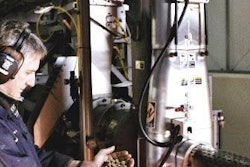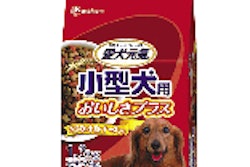Adverse food reactions and food intolerances, hypersensitivities and allergies are popular topics of discussion among pet owners and may affect 8-10% of our pets. These topics also constitute a large portion of the feedback to manufacturers' customer service lines. Complaints can range from vomiting and diarrhea to ear infections to skin and coat problems such as "hot spots," lesions, inflammation, reddening and chewing on feet and legs.
These problems are hard to ignore because they are so dramatic, uncomfortable and messy and strike at the very core of pet ownership by becoming a barrier to direct interaction. The problems may be linked by a common thread: the overreaction of the immune system to a dietary component, most probably a protein. The ultimate solution may depend on hydrolysis of proteins to render them hypoallergenic.
Battleship cells in action
True allergies to foods are the result of an antigen eliciting an immunoglobulin E (IgE) mediated response. In this stimulation of the immune system, an offending (antigenic) protein is thought to bridge, or crosslink, primed IgE receptors on the mast cell, a specialized "battleship" cell of the immune system. The formation of this crosslink causes the mast cell to degranulate, releasing chemicals such as histamines, cytokines, prostaglandins and enzymes into the circulation. Their job is to destroy the offending antigen and shore up the defenses at the tissue levelto repel and expel the invaders via vomiting, sneezing, swelling, etc.
The initial treatment for these reactions falls to modern pharmacology to blunt the immune response with compounds such as antihistamines and corticosteroids. These are short-term solutions with numerous side effects. The longer term solution focuses on eliminating the offending agent that has sensitized the animal's immune system.
One approach is to simply avoid the antigenic protein. With pets, so-called elimination diets have been somewhat successful. To really do it right, there is a multi-month routine of removing suspected proteins and then verification by replacing them in the diet. This regime can be challenging for pet owners, so compliance is iffy. Diets containing "novel" proteins are commercially available and often serve as a shortcut to the elimination regime. However, the efficacy of these diets is well below 100%.
Busting up the protein
Another technique first developed for human infants with milk hypersensitivities attempts to render the antigenic protein ineffective (hypoallergenic). For some proteins, this can be done by heat processing and for others through ultrafiltration. The most successful approach has been to enzymatically hydrolyze the protein down to the peptide level. In other words, bust the protein into smaller pieces.
Then why not just use crystalline amino acids? They are expensive and challenging to manage: They are hygroscopic, diet acceptability (palatability) can be poor and they can lead to problems of intestinal osmotic balance, causing diarrhea. So modification of the protein is preferable.
To be effective, the hydrolysis of the protein must decrease its size to such a point that it can no longer form the crosslink between the primed receptors on the mast cell: no bridge, no immune reaction. The reduction in size is thought to be near the peptide range (two or more amino acids).
A popular range cited is less than 10-12 kD or kilodaltons. But some research indicates the size can be as high as 70 kD; at the other extreme are indications that some proteins need to be less than 1-2 kD. A kD is the weight of a thousand hydrogen atoms, or 1.65 x 10-21 grams (pretty small). Thus, proteins that can be as large as 100,000 kD must be thoroughly demolished to evade detection by the immune system while still remaining palatable and delivering essential amino acids.
Hydrolysis how-to
In practice, the production of hydrolyzed proteins is similar to making a flavor digest. A specific blend of enzymes is added to the target ingredient (e.g., chicken, soy) and the pH is adjusted to an optimal level. The mix is heated in a reaction vessel until the desired hydrolysis is achieved and then stopped, either through chemical or thermal means (too much hydrolysis can lead to bitterness and thus palatability issues). The liquefied hydrolysate may be filtered and then spray or drum-dried.
Once the hydrolysis is complete, verification that the proteins have been sufficiently hydrolyzed is essential. It must be assured that the protein (now hopefully peptides) does not exceed the previously determined size threshold. This is often done by lab techniques known as size-exclusion gel-electrophoresis or modifications to generally accepted chromatography techniques.
Testing via measurement of antigenicity against established antibodies and animal validation, such as skin-prick tests and cross-reaction with sera IgE of sensitized animals, may be necessary to ensure the final outcome remains consistent over time. The exact nature of the enzyme cocktail, reagents, reaction times, process parameters and analytical techniques are fiercely protected by the manufacturers of these ingredients, and rightly so, since development takes a substantial investment in time and resources.
Sold through veterinarians
Diets based on these hypoallergenic hydrolyzed proteins are almost exclusively sold through veterinarians. In these diets, extruded or canned, hydrolyzed proteins may exceed 50% of the mix. So, it is important that they be well accepted by the animal and be easy to work with for the petfood manufacturer. This has not been a problem since hydrolyzed proteins generally retain good palatability for dogs and cats.
Hydrolyzed proteins can also be very functional ingredients providing binding, gelation and structure to the finished products. Protein sources that have been evaluated or used in pet diets include casein, whey, soybean, chicken and chicken liver.
The general principal behind hydrolysis of proteins is fairly simple in theory, but practical execution from hydrolysis to incorporation into pet diets can be challenging and expensive. However, these diets have proven effective at providing quality nutrition while flying under the immune system's radar.


















